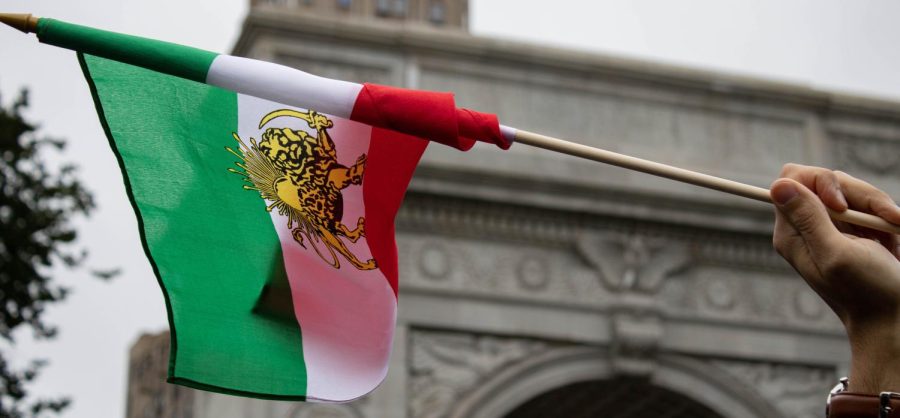A protester waves the flag of the Imperial State of Iran in the air on Oct. 1 as part of the Coordinated Global Protests Around the World at Washington Square Park.
Iranian American Community Responds to Death of Mahsa Amini, as Seen From NYC
The death of the 22-year-old Iranian Kurdish woman sparked protests throughout New York with hundreds advocating for women’s rights, justice and freedom
October 14, 2022
All sources within this article chose to withhold their full name out of fear of reprisal and/or safety concerns based on rumors, government surveillance of the Internet and social media, and the alleged presence of Iranian spies on behalf of the Iranian government at the rallies.
Protests were sparked across New York city following the death of 22-year-old Mahsa Amini in Iran on Sept. 16, who was detained by the Guidance Patrol, Iran’s “morality police.” Amini was arrested for allegedly wearing her hijab improperly, a violation of the country’s strict enforcement of compulsory hijab which has been in place since 1979.
Authorities attributed her death to a heart attack despite her family’s claim that she did not suffer from any health issues. Hours later, the Persian nation was engulfed in unrest as tens of thousands of civilians flocked to the streets across Iran to seek retribution. The ongoing protests and civil upheaval has resulted in at least 142 casualties, according to Iran Human Rights, although the death toll remains unconfirmed.
The 1979 Islamic revolution, which was held on International Women’s Day on March 8, introduced the obligation of wearing the hijab for all Iranian women. Over the years, the Iranian government has introduced more legal measures and social restrictions to enforce compulsory hijab laws. Since being elected as President of Iran, Ebraihim Raisi imposed a harsher law on hijabs, allowing the morality police to resort to physical force and verbal harassment, as well as the use of imprisonment and even forced disappearances, to enforce said law.
The demonstrations, which have been ongoing for two and a half weeks, have caused protests to begin in Canada, Germany, the United Kingdom and the United States. In New York City, the protests have amassed a crowd of more than a hundred Iranian Americans.
Fordham Community’s Response to Unrest in Iran
Departments within Fordham, such as the international studies department, have displayed their awareness about Iran. In his Comparative Politics of the Middle East class, John Entelis, professor of political science at Fordham Lincoln Center, discussed with his students the implications and potential outcomes of the women-led movement in Iran.
“From my experience regarding these kinds of movements, they don’t ultimately alter the balance of power between the state and civil society,” he said. “Among the problems we have seen is that while they are mobilizing a large number of people, attracting global attention, at the end of the day, the autocratic regime remains the same. Personalities may change, individuals might be replaced, but the systemic character of an autocratic regime will remain the same.”
Also fueling the protests is decades of socio-economic and political grievances, such as electoral corruption, freedom of political prisoners, mismanagement of the economy and demands for a modern secular democracy. Entelis highlighted how this ongoing protest is reflective of the overall frustration and anger against the Iranian regime but added that the inclusion of women distinguishes the current revolutionary movement from others.
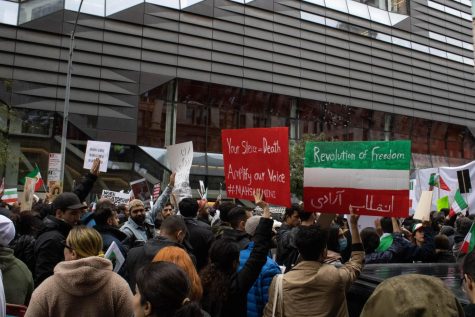
“There is a distinctive revolutionary dimension by the participation of women who are leading this, and end up creating political and social space that they may not have had before,” Entelis said.
Ariana, Fordham College at Rose Hill (FCRH) ’24 and an American-born Iranian student, has been using social media to stay up-to-date with what is happening in Iran. Expressing fear and anger over the violence in Iran, she mentioned how privileged she is to be where she is right now. She also noted disparities between herself and her distant relatives who currently live in Iran, people whom she knew would not be given the same opportunities.
“If you are in a position where you have the privilege, you have to protest for people who can’t be in that position,” Ariana said. “It is important to share a sense of community not just in Iran but around the world.”
Iranian Americans Rally for Amini
Enraged by Amini’s death, the Iranian American community in New York City organized several rallies in solidarity with Iranian women and protesters. Protests began in the Grand Army Plaza on Sept. 26, with the attendees organizing more demonstrations at the New York Times Building and throughout Lower Manhattan on Sept. 27 and Oct. 1.
A crowd of hundreds marched on Oct. 1 from 5th Avenue and 14th Street, two blocks away from Union Square, to Washington Square Park as part of a coordinated global protest that day. Participants in the rally ranged from Generation Z to Millennials. The crowd chanted in both English and Farsi, saying things such as “Say her name! Masah Amini!” and “People of Iran, Make their choice! New York Times, hear our voice.”
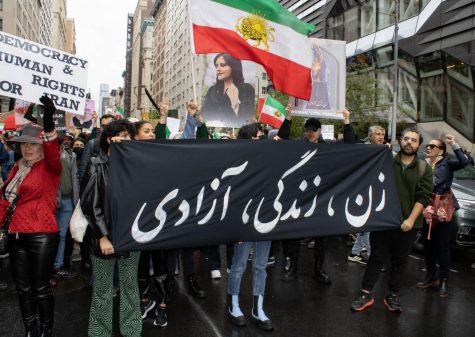
Women were seen cutting their hair, which is a gesture that has been featured in “Shahnameh: The Persian Book of Kings” as a sign of mourning, suffering and/or anger. This practice is now being used as a way to act in solidarity with women’s rights and voice support for what Iranians are calling a “revolution” against the theocratic regime ruled by Ayatollah Ali Khamenei, the current supreme leader of Iran.
Zoya, an Iranian protester who has lived in the U.S. for more than 40 years, noted that she lost several family members throughout the Iranian protests. She added that, despite this affliction, she continues to advocate for Iranian women’s rights alongside the young generation in the U.S.
“Iran is always in my heart. Iran is my home,” she said. “The people don’t deserve this. Enough is enough. The whole of Iran has become a jail.”
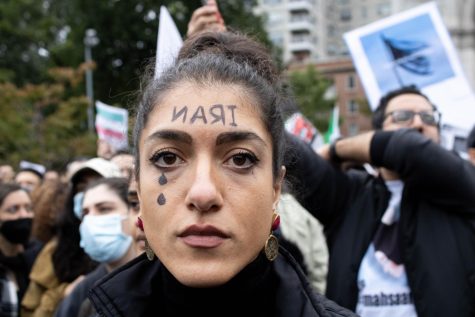
Zoya added that she was proud of everybody at the protest who was around the same age as Amini and noted that she is depending on them to carry “the flag of freedom.”
Other participants used this rally as a reflection of their own personal experiences living under the Iranian regime. Sanam, another Iranian protester who heard of Amini’s death from her family members at home, was heartbroken by the news but said that the incident is common in Iran.
“I was absolutely devastated, but it is not anything new in Iran as women have been oppressed for decades,” Sanam shared, “The morality police and the ayatollahs are the most violent regime.”
Amini’s death brought back the trauma of Sanam and her family’s personal encounter with the morality police. In 2016, she was stopped by the morality police while going out with her mother in Tehran, the nation’s capital. They were met with verbal abuses and discriminatory insults, with one of the officers commenting on their actions of wearing a loose hijab “unacceptable,” the very same action Amini was accused of committing. Sanam and her mother were not physically harmed, but the incident left an impression.
“If they take you, you are gone. No one in your family will be able to get in touch with you,” she said. “It is a terrifying experience of what could have happened to me.” Sanam, an Iranian protestor
“If they take you, you are gone. No one in your family will be able to get in touch with you,” she said. “It is a terrifying experience of what could have happened to me.”
Lian, a graduate student at Stevens Institute of Technology in New Jersey, recounted her personal experience of being arrested by the morality police. She said that she was abruptly approached by the police and was berated for having her sleeves rolled up, smoking, and her clothing was described as “too revealing.” She described this incident as “irrational” and “immoral.”
“They often resort to manipulative language. They are not telling you that you are arrested,” Lian said, “They just tell you to come with them so they can check your IDs and promise they are going to let you go after.”
Roberston, a public high school teacher in the Bronx, fled the Kurdistan region of Iraq due to political oppression in 1991. As a Kurd, she is no stranger to the chant, “Women, life, freedom!” (Jin-Jiyan-Azadî — Zen-Zendegi-Azadi), in reference to the Kurdish female freedom fighters in the 1990s. Robertson said she finds the chant, now a viral slogan among Iranian and Kurdish women around the world, more invaluable than ever before.
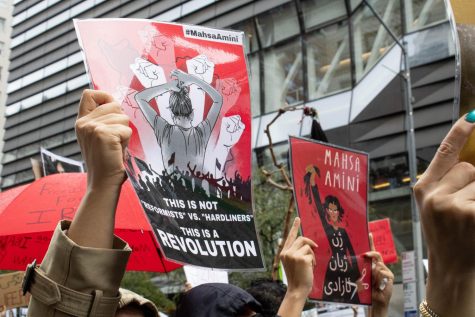
“(Women, life, freedom) now applies everywhere, whether it be among those who are suffering the deprivation of reproductive rights, inability to show their hair in public or lack the freedom to choose whom they marry,” Robertson said. “There will be no such thing as freedom if women are not free as well.”
Robertson added that even though she is grateful for the massive turnouts in these rallies for the past few weeks, she expressed disappointment at Western institutions, from the government to universities, for not taking further action in expressing support for the movement.
As of Oct. 11, Fordham University has not released an official statement about the incident. Other universities’ student-run newspapers, including Cornell University’s The Daily Sun and New York University’s Washington Square News, have reported on their respective community’s response to the Iranian protests, both of which stand in solidarity with the Iranian community. Ariana remarked how it is highly unlikely for Fordham, a Jesuit university, to raise awareness of the events unfolding, possibly due to the religious and political ramifications.
“As far as the administration goes, I don’t think they will do anything,” she said. “I am not expecting them to do anything and sadly that’s the truth.”
In spite of the lackluster response, she, like every other Iranian-American, continues to stand in solidarity with the Iranian people and raise awareness among members of the New York City community who have not heard about the issue.
